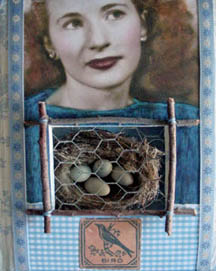
From my notebook. June 13, 2005
It’s mother’s day. We’re sittng on the porch outside my parents’ home. There’s six of us, sitting, talking– my mom and dad, by sister and her husband, and my husband.
A house sparrow has made a nest in the painted metal sailboats that hang on the wall. She’s tucked it beneath one of the brightly painted sails. There’s a little rust here and there where the paint has worn away. I can’t see the eggs, but I know they’re in there. Small, pale blue, lightly speckled.
We’ve scared the mother off, and she sits anxiously in a nearby shrub, waiting for an opportunity to return to her nest. Sometimes she tries to make it– bravely swooping in, but then quickly darting away when someone moves an arm or speaks too loudly.
I feel sorry for this bird for her and her anxiousness. I almost want to move everyone inside so she can get back to her nest.
She tries to approach again, resting on the top of the metal mast, watching warily, but then my dad waves his arm for emphasis and she flies off again. I’m agitated, like her. I can’t follow the conversaton. I watch her watch us, waiting.
She swoops again. This time she lingers on the edge of the boat and stays, gaining confidence. She slowly works her way behind that sail and settles down into the nest. She feels safe, hidden, protected. I see her small brown eye looking towards me. But I feel better now, knowing she’s back in her nest.
Two weeks later I’m back to help take care of Mom and to look after Dad. I walk onto the porch again to check on the birds. But when I look behind the boat for the nest, I find that it’s gone.
Inside the boats are seven delicate eggs. Remnants of the nest are strewn about here and there. I wonder if an animal got to it. But then, the eggs would probably be gone.
I ask my dad if he knows what happened to the nest.
“No. I didn’t even realize it was gone. Sandie,” he says to my mom, “do you know what happend to the nest that was in among the boats?”
“Oh those messy birds! I just can’t stand it. I had to clean up that mess.”
“But honey, that was a bird’s nest,” my father says gently.
“I just don’t care. They just can’t come around and leave a mess like that!”
“Okay, mom,” I say. “It’s okay.”
This is my new mom talking– the one who’s on the edge of being a stranger to me, and I to her. She’s the one I’m trying to get to know. Old mom cherished birds. Old mom took care of three or four bird feeders hanging full of seed near every window where she could watch them. Old mom could name every bird she saw. Old mom filled hummingbird feeders with sugar water, and called her daughters over every time a hummer came near.
My old mom was heartbroken by every bird who lost its life against an unseen window. She had bird guides and binoculars always at the ready. When two house sparrows built their house foolishily and precarioulsy in the narrow porch rafters two summers ago, she didn’t even want us going outside so as not to disturb them.
This new mother is a stranger to me. I want my old mother back, the one who would have done just about anything to protect the bird’s nest in the boat.

It’s five months since that I wrote that entry. I have created an altered book and written a poem about that moment. You can find it on my web site at Found Object Assemblages :: The Gift.